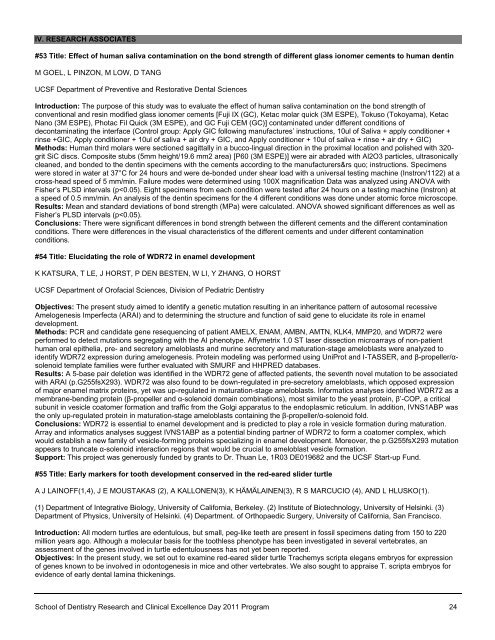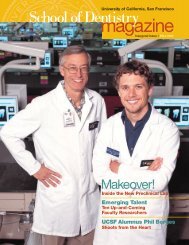Acknowledgements - UCSF School of Dentistry - University of ...
Acknowledgements - UCSF School of Dentistry - University of ...
Acknowledgements - UCSF School of Dentistry - University of ...
Create successful ePaper yourself
Turn your PDF publications into a flip-book with our unique Google optimized e-Paper software.
IV. RESEARCH ASSOCIATES<br />
#53 Title: Effect <strong>of</strong> human saliva contamination on the bond strength <strong>of</strong> different glass ionomer cements to human dentin<br />
M GOEL, L PINZON, M LOW, D TANG<br />
<strong>UCSF</strong> Department <strong>of</strong> Preventive and Restorative Dental Sciences<br />
Introduction: The purpose <strong>of</strong> this study was to evaluate the effect <strong>of</strong> human saliva contamination on the bond strength <strong>of</strong><br />
conventional and resin modified glass ionomer cements [Fuji IX (GC), Ketac molar quick (3M ESPE), Tokuso (Tokoyama), Ketac<br />
Nano (3M ESPE), Photac Fil Quick (3M ESPE), and GC Fuji CEM (GC)] contaminated under different conditions <strong>of</strong><br />
decontaminating the interface (Control group: Apply GIC following manufactures’ instructions, 10ul <strong>of</strong> Saliva + apply conditioner +<br />
rinse +GIC, Apply conditioner + 10ul <strong>of</strong> saliva + air dry + GIC, and Apply conditioner + 10ul <strong>of</strong> saliva + rinse + air dry + GIC)<br />
Methods: Human third molars were sectioned sagittally in a bucco-lingual direction in the proximal location and polished with 320grit<br />
SiC discs. Composite stubs (5mm height/19.6 mm2 area) [P60 (3M ESPE)] were air abraded with Al2O3 particles, ultrasonically<br />
cleaned, and bonded to the dentin specimens with the cements according to the manufacturers&rs quo; instructions. Specimens<br />
were stored in water at 37°C for 24 hours and were de-bonded under shear load with a universal testing machine (Instron/1122) at a<br />
cross-head speed <strong>of</strong> 5 mm/min. Failure modes were determined using 100X magnification Data was analyzed using ANOVA with<br />
Fisher’s PLSD intervals (p




